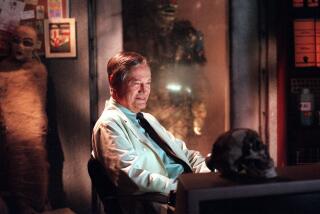Blessed Endorsement
- Share via
Patrick Goldstein’s article about the fake quotes of fake movie critics and the general flimflammery present lately in movie marketing (“Just Win, Baby . . . ,” June 26) reminded me of a story the late actor Keye Luke liked to tell.
Luke, perhaps best known for his role of the Chinese detective’s No. 1 son in a dozen of the old “Charlie Chan” movies, worked as a staffer in the RKO Radio Pictures advertising department before starting his acting career, and he was a member of the team that created ad copy for “Cimarron,” an RKO western based on an Edna Ferber novel. According to Luke, he and his fellow hucksters were tossing around potential ad lines for the movie one day, and their rhetoric became increasingly overheated.
Finally, they pulled out all stops, producing one that even dared to invoke the power of the Almighty: “ ‘Cimarron’--Marked by God With a Sign of Greatness!” It worked. “Cimarron” won three Oscars, including that for best picture, for 1930/31, thus for the first time confirming God’s credentials as a shrewd movie critic.
DAN BAGOTT
Tarzana
*
While I agree with Goldstein’s overall observations, a few historical inaccuracies jumped out at me in his . . . eh, Mr. Glick’s, memo. While “Jaws” was certainly an unfortunate turning point in the Hollywood marketing mentality, prior to 1975 non-adults certainly were a large target market. Movies like “I was a Teen-age Werewolf,” “The Blob,” the rock ‘n’ roll movies of the late ‘50s, the “Beach Party” cycle, Elvis movies, the output of Roger Corman and American-International all go to show that the teen market had been discovered by at least the late ‘50s.
“Entertainment Tonight” hit the air much earlier than “the late ‘80s.” It began in 1981 and is now in its 20th year. Granted, once upon a time, it was much less the PR mill that it now is.
And while his article seems to assert that local TV critics fell out of this trend in the late ‘80s, local TV news movie critics have been a mainstay on many stations throughout the country, even in smaller markets, since the early ‘70s. This trend was actually probably an outgrowth of the “happy talk” formats of that era.
STEVE HAMMEL
West Hollywood
More to Read
Only good movies
Get the Indie Focus newsletter, Mark Olsen's weekly guide to the world of cinema.
You may occasionally receive promotional content from the Los Angeles Times.










